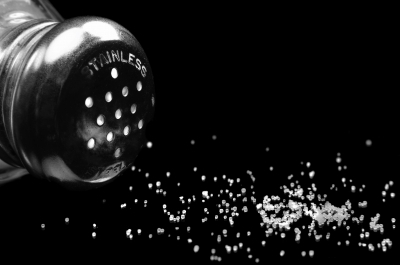
What would you guess is the number one source of salt in your diet?
Potato chips, pretzels, pickles?
Well guess again!
BREAD
I was just as surprised that the number one food is bread. Wow! Why is that? Bread doesn’t taste salty, but the leavening agents put in bread products are the source of sodium. Sodium chloride (regular salt) and sodium bicarbonate are used in bread to give it texture and make it rise.
We eat a lot of it. Bread accounts for about 30% of calories in the average American diet. A slice of bread contains 100-200 mg of sodium, a whole English muffin, 200 mg, 6 1⁄2 inch pita 300, a piece of cornbread 400, and a whole bagel 500-600 mg. You might want to skip that whole plain bagel, use smaller slices of bread or have an open-faced sandwich to lower your salt exposure.
Other top culprits are cold cuts and cured meats, pizza, poultry, soup, hamburgers. Foods with salt on the outside like potato chips or pretzels may taste saltier than they are.
How much is recommended?
Your daily recommended sodium intake should be less than 2,300 mg based on the 2010 Dietary Guidelines for Americans. However, if you are over 50, African American of any age, or have hypertension, diabetes, or chronic kidney disease, only 1,500 mg is recommended. So that bagel with 600 mg of sodium will really makes your sodium add up fast.
The Top 10
The Center for Disease Control (CDC) published the top 10 sources of salt in our American diet. Almost half of the sodium in our diets came from these 10 food sources. Here’s the list:
- Breads and rolls
- Cold cuts/cured meats
- Pizza
- Poultry
- Soups
- Sandwiches
- Cheese
- Pasta mixed dishes
- Meat mixed dishes
- Savory snacks (chips, puffs, popcorn, and pretzels)
Even your beloved pizza is on the list. Think about the ingredients-crust, tomato sauce, cheese, toppings like pepperoni-all are high in sodium. Just two pieces can bust your daily sodium allotment.
The Bone Connection
So why am I talking about sodium and bones? That’s because they are interrelated. You get rid of sodium through your sweat and urine. Sodium that goes out in the urine drags calcium with it. Therefore, the more sodium out, the greater loss of calcium. Too much calcium in your urine may cause kidney stones and contribute to bone loss. People who eat high-salt diets are prone to developing kidney stones and osteoporosis.
Be aware! Watch your salt intake. Remember, it’s not the saltshaker; it’s what you are eating! Check out the Nutrition Facts for sodium next time you are shopping and choose the lower sodium products.
Source: CDC
Photos: FreeDigitalPhoto.net

